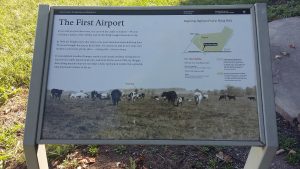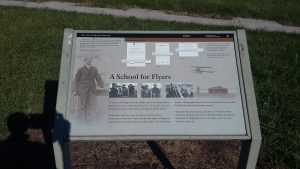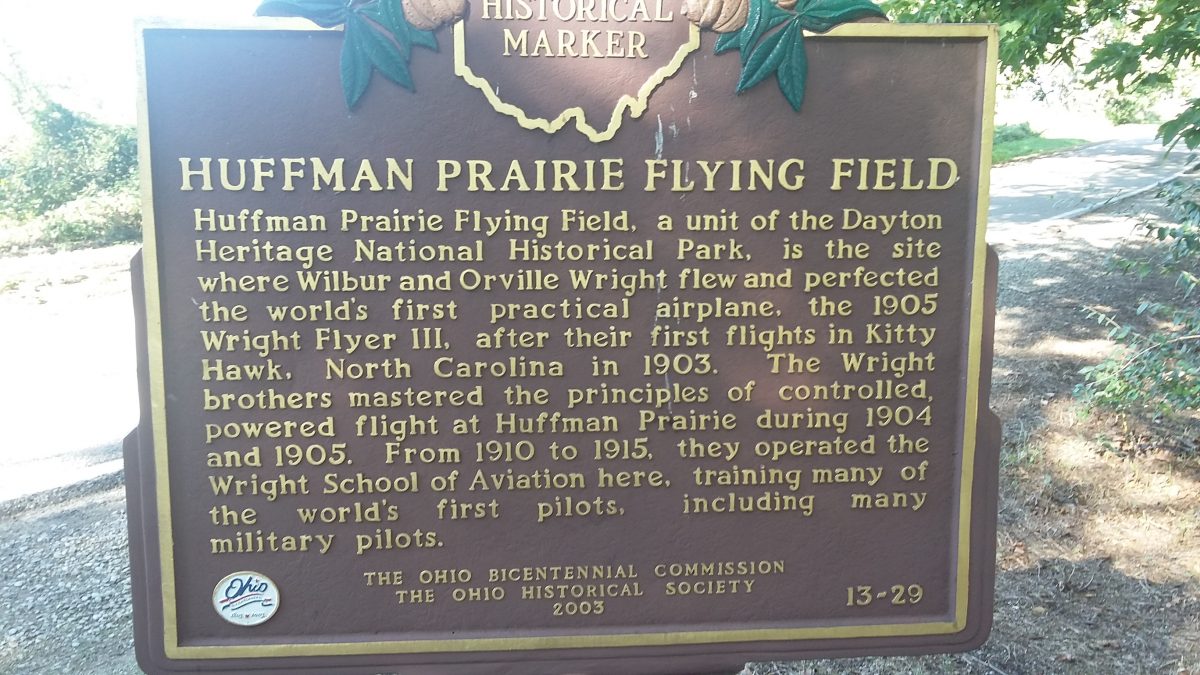Robert Novells’ Third Dimension Blog
September 16, 2016
Good Morning,
Hope all is well with you and yours and welcome back to the 3DB. This week I want to talk about the Wright Brothers after Kitty Hawk. I am currently in Dayton on business so I have taken advantage of my time to visit all the historical aviation sights and to learn a little more about my aviation roots; however before I talk about the Wrights after Kitty Hawk lets talk about the Wrights before Kitty Hawk.
Enjoy……
The Wrights
Before, And After, Kitty Hawk
Orville Wright
(August 19, 1871 – January 30, 1948)
Aviator and inventor, Orville was born in Dayton, Ohio, to Milton and Susan Koerner Wright. He was the sixth of seven children born to the Wrights, five of whom survived infancy. Orville attended school in Iowa, Indiana, and Dayton, where future poet Paul Laurence Dunbar was part of his class at Central High School. However, Orville never graduated from high school, having not earned several credits required for a diploma. Having already decided to pursue a career as a printer, Orville was not worried about lacking a diploma; instead, he and Wilbur established a printing shop near their home in west Dayton.
Source Document
Wilbur Wright
April 16, 1867 – May 30, 1912
Aviator and inventor, Wilbur was born near Millville, Indiana, to Milton Wright and Susan Koerner. He was the third of seven children born to the Wrights, five of whom survived infancy. Wilbur moved often as a child due to his father’s ministry in the Church of the United Brethren in Christ, and he attended primary schools in Iowa and Indiana. He attended high school in Richmond, Indiana, but did not receive his diploma with the rest of the class of 1884 as his family moved to Dayton, Ohio, before his commencement ceremonies. In Dayton, Wilbur enrolled in the college preparatory program at Central High School, but a freak hockey injury during the winter of 1885-1886 caused him to convalesce at home for three years. During those years he nursed his ill mother, who died of tuberculosis in 1889, and read widely in his father’s extensive library.
Source Document
Orville and Wilbur
The Quest -From Beginning To End
In 1889, Wilbur and brother Orville – four years his junior – decided to form a business partnership and open a printing shop. Between May of 1889 to August of 1890, they published two local newspapers, the West Side News and the Evening Item. The newspapers failed in a saturated journalistic market, but their printing shop fared better. In 1890, they moved it to new quarters in the recently-built Hoover Block on West Third Street near the Wright family home. It was there that the Wrights printed the Dayton Tattler, a short-lived newspaper for the local African American community that was edited by a high school acquaintance of Orville’s, Paul Laurence Dunbar. Dunbar later gained national renown for his poetry.
Though printing became an overly predictable business to Wilbur and Orville, they maintained their shop until 1899, when they sold their press and type. Meanwhile, in the spring of 1893, they responded to the bicycling craze sweeping the United States by opening a bicycle repair and sales shop. Business at the cycle shop boomed, and it overtook the printing shop to become their primary business. While other companies produced most of the bicycles the Wrights sold, they also sold cycles made at their own shop. Few bicycles built by the Wrights exist today. The Wrights left the bicycle business in 1908.
Milton piqued the interests of Wilbur and Orville in aviation in 1878, when he gave them a toy helicopter after one of his trips in the west. The 1896 death of German aviation pioneer Otto Lilienthal in a glider crash, rekindled the brothers’ latent interests in flying. Drawing upon similarities between bicycling and flying, Wilbur and Orville began researching aerodynamics, propulsion, and control. Their research did not occur in a vacuum; they investigated the experiments of other aviation pioneers, writing to the Smithsonian Institution in Washington, D.C., for suggestions of relevant readings in 1899. The Wrights progressed from kite to glider research and, valuing privacy while needing consistently high winds, moved glider experimentation to the sand dunes of Kitty Hawk, North Carolina. Research and development activities took place at the cycle shop on West Third Street in Dayton. Through experimentation at the cycle shop using a small, homemade wind tunnel, the Wrights designed the airplane that made the first powered, controlled, sustained flight on December 17, 1903. Experimentation and flight testing over the next decade at Huffman Prairie (Huffman Prairie Flying School adjoins Wright Patterson AFB), eight miles (13 km) east of Dayton, and at Kitty Hawk, resulted in the development of practical airplanes that could remain airborne for as long as fuel reserves permitted.
Orville and Wilbur were wary of competitors copying their designs while patents pended and did not fly between late 1905 and the spring of 1908. Orville returned to the air that spring to conduct airplane trials for the U.S. Army, while Wilbur ventured to France to conduct trials for potential French investors. The Wrights signed a contract with the U.S. Army stating that they would provide an airplane capable of flying for one hour at a speed of forty miles per hour (64 km/h) for $25,000 without performance incentives. While the trials at Fort Myer in Arlington, Virginia, were generally successful, one flight ended abruptly when Orville’s plane crashed. The accident seriously injured Orville and killed his passenger, Lieutenant Thomas Selfridge. Orville’s injuries, which included a broken thigh and broken pelvis, gave him pain for the remainder of his life. He and sister Katharine joined Wilbur in France after his injuries healed.
In 1909, the Wrights and several prominent industrialists created the Wright Company to market Wright airplanes. Wilbur became the company’s first president, with Orville as one of two vice-presidents (Andrew Freedman being the other). Orville became president of the Wright Company upon Wilbur’s death of typhoid fever in 1912. Orville also served as executor of his brother’s estate.
In the years after Wilbur’s death, Orville became an elder statesman among aviators. He, Katharine, and Milton moved into Hawthorn Hill, a mansion in the Dayton suburb of Oakwood, in 1914. Orville sold his interests in the Wright Company in 1915, remaining with it for a year as a consulting engineer. He also built a laboratory on Broadway in west Dayton, close to the last site of the Wrights’ cycle shop and the family’s former home at 7 Hawthorne Street. Orville worked on a variety of projects at this laboratory, designing devices to ease tasks around Hawthorn Hill. He also served on several aviation commissions and boards, including that of the National Advisory Committee on Aeronautics, the predecessor agency of the National Aeronautics and Space Administration. Orville, who never married, died in Dayton of a heart attack on January 30, 1948 and is buried at Woodland Cemetery.
Huffman Prairie Flying Field
When the Wright brothers returned to Dayton, after their historic first flights at Kitty Hawk, North Carolina, on December 17, 1903, they looked for a suitable flying field closer to home. Dayton banker, Torrence Huffman allowed the brothers to use his pasture, which was located eight miles northeast of Dayton, rent-free. Here in 1904 and 1905, through a series of unique experiments, the Wright brothers mastered the principles of controlled, powered flight and developed the world’s first practical airplane.
In 1904, the brothers made 105 flights, totaling 49 minutes in the air with their 1904 Wright Flyer II. With this flying machine, they made the first turn and the first circle in the air. They also employed a starting derrick for the first time and Wilbur set a new distance record.
When the brothers returned to the Huffman Prairie for the 1905 flying season, they brought along an improved machine, the 1905 Wright Flyer III. This flying machine, which evolved throughout 1905, could bank, turn circles, and make figure-eights. On October 5, 1905, Wilbur piloted the plane for a world record of over 24 miles in 39 minutes. About two weeks later, the brothers ended their experiments for 1905 feeling that they now had a practical airplane that they could market. In the 1905 flying season, the brothers stayed aloft for 262 minutes in just 50 flights.
The Wright brothers returned to Huffman Prairie Flying Field in 1910. The field was used by their new business, The Wright Company, as a testing ground, flying school, and home to their exhibition team. The Wright Company ceased use of the flying field in 1916.
Today, Huffman Prairie Flying Field is located on Wright-Patterson Air Force Base. It was designated a National Historic Landmark in 1990.
Source Document





Tomorrow I am off to The Wrights Shop in Dayton, make a visit to their graves of the Brothers Wright, and then to the Air Force Museum. Have a good weekend, keep family and friends close, and stop by again next week when we will talk about ?????
Robert Novell
September 16, 2016









